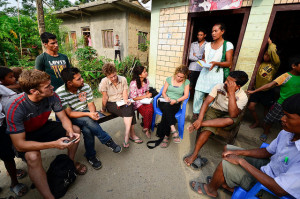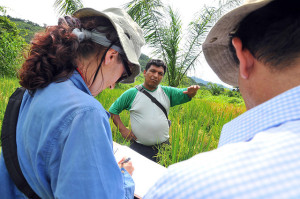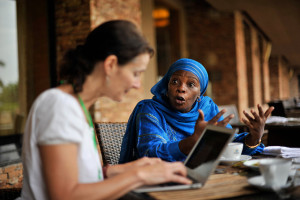Originally published at CIFOR’s Forests News

Gender issues are one focus of the CGIAR Research Program on Forests, Trees and Agroforestry (FTA), so the recent workshop “Disciplining Gender in Undisciplined Environments: Tensions in environment and development practices in the North and South” offered a welcome opportunity to reflect on gender research. The workshop was co-organized by the Center for International Forestry Research (CIFOR) and the Swedish University of Agricultural Sciences. CIFOR’s Markus Ihalainen and Bimbika Basnett wrote about the workshop for CIFOR’s Forests News, together with Seema Arora-Jonsson, Louise Fortmann and Susan Buckingham.
One of the major successes during the past 40 years of feminist scholarship and activism has been paving the way for gender issues to be recognized in environmental policies, interventions and institutions.
Resources and attention directed at promoting women and girls’ livelihoods are expanding. ‘Gender mainstreaming’ of environmental organizations is increasingly accepted as a measure of relative success and institutional inclusiveness.
Yet gender scholars are increasingly concerned that despite the advancement of gender theories during these past decades, the way in which gender is approached in policy and practice today has remained fairly banal.
So how do we bridge the gap between gender theory and practice? How can gender scholars use their expertise to bring about change? What needs to be done, and which challenges and potential concerns should we be mindful of?
These were some of the central questions discussed at a joint workshop organized by the Center for International Forestry Research (CIFOR) and the Swedish University of Agricultural Sciences (SLU). The workshop, titled “Disciplining Gender in Undisciplined Environments: Tensions in environment and development practices in the North and South,” was held during the International Conference of the European Network of Political Ecology (ENTITLE) in Stockholm from March 20-24.
The discussions provided food for thought on the topic from different standpoints. These included 1) gender scholars who routinely advise development agencies on how to better integrate gender in their policies and programs, 2) academic researchers committed to leveraging their research to inform gender inclusive change, and 3) gender specialists in environmental organizations such as CIFOR.
GENDER IN THEORY

Workshop participants highlighted the complex ways in which contemporary feminist and gender studies theorize about the term gender. Gender identities are seen as fluid, dynamic and plural – not only confined to male and female.
Gender is relational and context-specific. Gendered power relations intersect with other social relations such as race, ethnicity and class, thereby producing specific experiences that cannot be captured in binary analyses of women and men alone.
While gender norms, structures and practices constrain the social, economic and political freedom that individuals are able to exercise, those norms are also constantly subject to change through political struggles, negotiations and social change.
GENDER IN POLICY AND PRACTICE

As gender enters the mainstream in environmental research, policy and practice, participants expressed their unanimous concern that gender was being stripped of its politics and over-simplified. As one session presenter put it, gender has turned into “a tick box exercise rather than (being) transformational.”
A presentation that reviewed papers published by the CGIAR on gender and climate change topics over the past four years found that despite increasing calls from gender scholars for more nuanced and relational approaches, gender was often approached as simplistic male-female binaries. The papers portrayed statistical and qualitative differences as inherent to men and women, rather than as products of social structures and everyday experiences.
This is a problem because gender analysis should not be conducted in this simplistic manner, and also because such papers, which are targeted at policy makers and practitioners working on climate change, inadvertently risk producing or perpetuating harmful gender stereotypes.
On the other hand, gender and feminist theoretical insights have a lot to offer for environmental policy and practice when properly conducted. Applying gender theories correctly can help policy-makers and practitioners better understand who wins, who loses, why they do and what can be done about it.
Another presentation at the workshop showed that the REDD+ program in Mexico incentivized women, young people and indigenous groups to participate in decision-making processes. But women’s overall participation was low and those who did participate were mostly older, richer and better connected. Policy makers who want to promote women’s participation in REDD+ thus need to be cognizant of which types of women are incorporated and identify entry points to foster broad-based inclusion.
TRANSLATING GENDER THEORIES

To bridge the gap between contemporary gender theory and current practice, practitioners should combine theories in ways that make gender theories more meaningful. Concepts need to be translated into tools and methods for enabling applied researchers, policy makers and practitioners alike to move away from simplistic assumptions.
Yet there is little reliable data to corroborate such generalizations. By portraying women as victims in need of resilience training, the responsibility for dealing with climate change is left up to individuals, rather than on governments and the global community to address the problem in the first place.
RECOGNIZING AND EXPANDING BOUNDARIES
Participants pointed out the importance of being cognizant of the boundaries of contemporary theorizing and advocacy on gender and environment. Discussions took place on how gender scholars working on environmental issues can broaden their application of gender theories.
Shedding light on the ways in which oppressive and pervasive masculinities can disadvantage many men and women in the face of climate change was brought up as an important area of future work. Gender scholars reiterated how and why ethnicity, class, race and similar social variables are important to integrate in gender analysis.
Additionally, there has been very limited research to date on the connections between environmental change and queer theory and/or LGBT issues. Much less work exists on places such as Russia and China where research and discussion on gender equality could be politically controversial.
Top-down initiatives preaching the ‘international gender equality agenda’ also need to be mindful of contexts where globally-defined meanings of gender and gender equality might not easily or uniformly translate. For example, one of the presenters mentioned that in the Indonesian community where she conducted ethnographic research, there was no clear definition for gender in the local language and gender inequality did not matter for women and men alike.
Would a gender analysis in such a context actually introduce gender among seemingly gender egalitarian communities? This, of course, depends on how gender is understood – if it is understood as a category that signals the male-female binary, the use of the term gender could introduce difference. But a careful and contextual gender analysis could bring to light aspects that are otherwise invisible in regards to the way that power is organized in the community.
This particular discussion served as a reminder of the importance of adopting a reflexive approach, especially in cross-cultural research. Participatory methodologies that would allow researchers and those researched to co-produce knowledge were seen as one way of reconciling local priorities and conceptions with global normative commitments to gender equality.
STRIKING A BALANCE
The workshop shed light on the problems associated with binary interpretations of gender and simplistic assumptions about women, while highlighting the advantages of more sophisticated approaches to gender. While standpoints differed, there was a strong consensus on the need to transform the way gender is conceptualized in current policy and practice in forestry and on environmental issues.
But what is the right balance to strike between theory and practice, and is too much theorizing on gender even meaningful or useful? In visualizing this change and taking the necessary steps towards it, gender scholars need to bear in mind the central essential question: “What or whom is our gender research for?”











